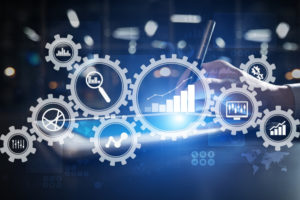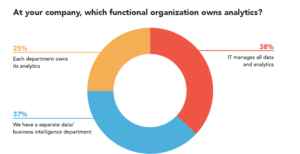
Composable Analytics: Where Headless BI Meets Your Data in the Cloud

(Wright-Studio/Shutterstock)
Application development has gone composable. It’s generally agreed that huge monolithic applications should be broken up into smaller, individual services and accessed via Web services and APIs. But what about data analytics and the huge data sets it relies on? Well, some are saying the time is ripe for composable analytics too.
Gartner is one of the leading backers of the composable analytics idea. In a September 2020 report titled “Composable Analytics Shapes the Future of Analytics Applications,” Gartner analyst Julian Sun wrote:
“Many companies have adopted embedded analytics in order to bring analytics closer to business processes and improve decision making. Microservices or cloud-based tools add agility and enable users to receive business value more quickly. With augmented analytics becoming more prevalent within solutions, it is becoming possible to package and embed more advanced analytics capabilities hand-picked from the analytics stack within the business process,”
One of the leading purveyors of composable analytics in practice is GoodData. Known primarily for its embedded analytics solutions, GoodData is transitioning its tools and capabilities to embrace the concept of composable analytics, which it dubs headless BI.
According to GoodData CEO Roman Stanek, the combination of massive processing power and huge data sets in cloud data warehouses sets the stage to enable users to tap into analytic insights via APIs, leaving bulky desktop-based BI tools and batch data transfers behind.

Self-service analytics is the top priority in 2022, according to GoodData’s survey (Source: “The Future of Analytics: Priorities and Plans for Business Analytics in 2022 and Beyond”)
“From our perspective, and we are not the only ones, we believe the future is what Gartner calls composable analytics, and what we call headless BI, where you essentially create this kind of API-first analytics, and then you allow all of your consumers, internally and externally, to use some low-code, no-code tool to build their own applications, build their own insights, build their own dashboards, and so on,” Stanek tells Datanami.
“It’s the streamlining of analytics and making it more real-time and more cloud-based, rather than copying data from Teradata and Tableau and doing some sort of an on-prem analysis, some sort of desktop analytics, and putting it into a PDF file, and emailing it to people,” he continues.”
GoodData recently tapped a Gartner subsidiary called Pulse to produce a white paper on the topic. Titled “The Future of Analytics: Priorities and Plans for Business Analytics in 2022 and Beyond,” the paper is based on a survey of 200 decision-makers at companies with 500 to 10,000-plus employees.
The survey concluded that the number one analytic priority for 2022 among all companies is the delivery of self-service insights and dashboards (as it was for 2021), followed by scalable architectures and real-time data updates.

Three distinct groups manage analytics, according to GoodData’s survey (Source: “The Future of Analytics: Priorities and Plans for Business Analytics in 2022 and Beyond”)
This was particularly true for smaller companies, or those with fewer than 10,000 employees. Companies with more employees tend to have a separate teams that own analytics (either IT or a dedicated data and analytics team), GoodData says in its report, whereas each department in smaller companies tends to be responsible for analytics. For larger companies, machine learning was the number one priority.
If data democratization is going to happen, data analytics capabilities will need to be brought to the longtail of companies with fewer than 10,000 employees. Composable analytics, or headless BI, presents a good mechanism to do that, Stanek argues.
“It’s very similar to how you use Gmail. In Gmail, you don’t move Gmail to your desktop. You just use cloud-based Gmail,” he explains. “With this kind of headless BI and composable analytics, I’m not moving data to my desktop. I’m actually using some sort of a lightweight UI and I’m manipulating data in the cloud, on Snowflake and Redshift and Databricks and so on.”
It’s not just the point of analytic consumption, i.e. the dashboard, that plays a roll on this new composable analytics stage. All of the supporting cast members–from the ETL tools or decomposed data extraction, transformation, integration, and quality tools–get to play a part.
“We call it a cloud data value chain,” Stanek says. “We are moving into the new paradigm where the cloud data warehouse becomes the center of gravity of data. Your data at no point moves out of the cloud data warehouse. You do everything in place.”
It doesn’t matter if some the data is located in a cloud data warehouse or a data lake, Stanek says, or whether the user wants to query it using an analytics tool or a machine learning notebook. Once the integration work is completed and the embedded application is ready, it will enable users to get to the data quickly and become productive more quickly than would have been otherwise possible. That’s the promise anyway.
“The main advantage is it’s real-time. You don’t work with stale data that you had to copy,” Stanek says. “And also because it’s cloud-based, it’s much easier to collaborate, so you work on the same data sets someone else is working on. You can build an app and you can share it with the rest of the company.”
Whether you call it composable analytics or headless BI, it would seem that it’s likely to be in your future for 2022–and beyond.
Related Items:
Composite AI: What Is It, and Why You Need It
Gartner Shuffles the Technology Deck with Latest ‘Hype Cycle’ Report
GoodData CEO Sees Growth in Analytics Biz Shakeup































